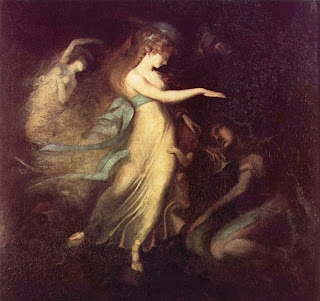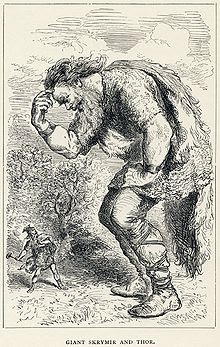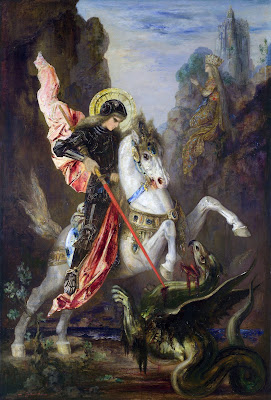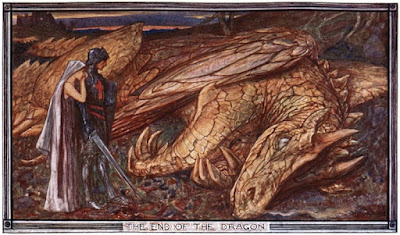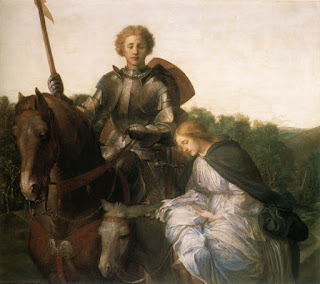The Faerie Queene
Book 1
Contayning
The Legende of the Knight of the Red Crosse
Or
Of Holinesse
So far this is proving a much more difficult read than anticipated. It does get easier as you get used to the style and delivery, but there is so much information and I do want to cover as much as I can in my reviews in case I never read it again. I mean I want to read it again, but right now it’s rather exhausting.
Cantos I to VI introduced us to the Redcrosse Knight and Una, documenting Redcrosse’s descent into sin and Una’s unwavering faith in him. The following cantos conclude Book I.
Canto VII
The Redcrosse knight is captive made
By Gyaunt proud opprest,
Prince Arthur meets with Vna great-
ly with those newes distrest.

When Duessa returns to the House of Pride to find Redcrosse gone, she hurries quickly after him and finds him near a fountain, resting in the shade. Using her manipulative wiles, she reproaches him for his dissertion and soon all is well between them. However, this fountain is not a regular fountain but a nymph cursed by the goddess Diana for laziness, and anyone who drinks of it will suffer faintness and lose his strength. Is the spiritual lethargy of the nymph a parallel to the spiritual laziness of Redcrosse as he allows himself to be drawn further away from Truth? In any case, of course Redcrosse drinks from the fountain and is soon content to sit chat though his strength fades and he becomes careless of his reputation. Suddenly a great noise is heard and the earth trembles, as a giant, Orgoglio emerges from the wood. Redcrosse has no time to take up his armour or weapons but Duessa pleads with the giant, promising them both as slaves in exchange for his good treatment. He takes Duessa, seating her on a monster with seven heads, but throws Redcrosse into the dungeon. The Dwarf, however, has seen all and gathering up his master’s armour and departs, whereupon he meets Una on the road flying from the lecherous Paynim. Seeing the Dwarf, she nearly faints and the Dwarf, equally unhappy, must help her recover to tell his tale of Redcrosse. Although his words almost tear her heart in two, she gains control and they set off together, soon coming across a knight with a gorgous diamond shield, who wishes to help her. After spurning his assistance, she finally relates her story of her father and mother being held captive by the dragon, her travels to the court of Gloriana, the Faerie Queene, for help, and her hero Redcrosse who has been diverted and now is captive of the giant. This knight, whom we believe is King Arthur, pledges to help Una in her distress.
Canto VIII
Faire virgin to redeeme her deare
brings Arthur to the fight:
Who slayes the Gyant, wounds the beast,
and strips Duessa quight.
Una and Arthur search for Redcrosse and with the Dwarf’s help, soon arrive at the castle of the Giant. Bringing out a gold-tasselled magic horn, he blows, all the doors of the castle fly open, and the Giant investigates. They fight, and as the giant, Orgoglio, misses with a club-strike, Arthur turns and lops off his arm. Duessa, on her monster, rushes to his aid, but when she is blocked by Arthur’s squire, she puts a spell on him and sends her monster to finish him off. Rushing to his aid, Arthur strikes off one of the heads of the monster and:
“His monstrous scalpe downe to his teeth it tore,
And that misformed shape mis-shaped more;
A sea of bloud gusht from the gaping wound,
That her gay garments staynd with filthy gore,
And ouerflowed all the field around;
That ouer shoes in bloud he waded on the ground.”
Enraged, the giant attacks again, knocking Arthur to the ground but, behold, the knight unveils his shield and everyone is hit with a most wondrous, brilliant brightness which dazes the giant and Arthur is able to cut off his leg, then his head, where on his death, Orgoglio vanishes. Grief manifests in anger in Duessa as:
“Her golden cup she cast vnto the ground,
And crowned mitre rudely threw aside;
such percing griefe her stubborne hart did wound,
That she could not endure that dolefull stound,
But leauing all behind her, fled away.”
But the squire halted her flight and brought her back to his master. In contrast, Una is all composure and modesty:
“The royall Virgin, which beheld from farre,
In pensiue plight, and sad perplexitie,
The whole achieuement of this doutfull warre,
Came running fast to greet his victorie,
With sober gladnesse, and myld modestie,
And with sweet ioyous cheare him thus bespake;
Faeire brauch of noblesse, flowre of cheualrie,
That with your worth the world amazed make,
How shall I quite the paines, ye suffer for my sake?”
Arthur goes off in search of Redcrosse and discovers an old wizened man, the giant’s foster-father, with a ring of keys about him. Strangely, he is always looking backwards instead of forwards, and will not answer any of Arthur’s questions. Finally, in frustration, Arthur takes the keys and begins to search the dungeons finding the remains of children and the blood of Christians in its depths. Redcrosse is discovered but he is wan and weak, although in spite of his appearance, Una is overjoyed to see him. Instead of killing Duessa, they strip her of her garments and, when naked, they find she is an ugly old hag. Spenser’s description is appalling:
“Her craftie head was altogether bald,
And as in hate of honorable eld,
Was ouergrowne with scurfe and filthy scald;
Her teeth out of her rotten gummes were feld,
And her sowre breath abhominably smeld;
Her dried dugs, like bladders lacking wind,
Hong downe, and filthy matter from them weld;
Her wrizled skin as rough, as maple rind,
So scabby was, that would haue loathd all womankind.“
Ugh! Duessa flees to the wilds to hide herself and our knights and lady rest at the castle.
Canto IX
His loues and lignage Arthur tells
The knight knit friendly bands;
Sir Treuisan flies from Despayre,
Whom Redcrosse kight withstands.

Before they leave the castle, Una begs Arthur to share his history. He was raised by an old man named Timon who, in his youth, was concerned with battles and bravery but later became wise, and he raised Arthur to know virtue. Merlin was also his mentor, but the wizard would not disclose his parentage, only revealing that he was son and heir to a king. Una wants to know why he is in Faery land, but Arthur does not know, only that he has a wound that bleeds and perhaps there is an eternal reason for his presence which he does not understand. He has been looking for his lady-love, a Queen of the Faeries, whom he is not sure is real or a dream. Una and Redcrosse wish him well in his journeys, they exchange gifts, Arthur giving a potion that can heal all wounds, and Redcrosse bestowing on his benefactor a book to save souls. They then part, although Una is uncertain whether Redcrosse is fit for battle.
But heavens, what should come upon them but a fleeing Knight, looking behind him as if the hounds of hell were on his heels, with a rope hanging from his neck. Redcrosse forces the Knight, Sir Trevisan, to stop and tell his story. He was travelling with another knight, Sir Terwin, who was suffering from unrequited love. One day they met with a terrible villain called Despaire, who played on their griefs and tried to convince them to kill themselves, Sir Terwin with a knife and the Knight with a rope. With Terwin, Despaire succeeded, but the Knight, Trevisan, fled in terror. Redcrosse is puzzled over the power of Despaire’s words, but the Knight explains the subtlety of Despaire, how he stealthily weakens one’s power. Undaunted, they find the cave of Despaire and Redcrosse confronts him, whereupon Despaire gives a long speech on life and wonders why Redcrosse would want to prolong it, since it is full of suffering and the longer one lives the more chance he has to sin. Death is the end of woes and shouldn’t we all welcome it? Redcrosse is moved by the speech, so Despaire shows him damn’d ghosts and torments of hell-fire suffering. Unable to bear it, Redcrosse is about to end his life when Una flies into the fray, snatching the knife from his hand, and chiding him for his weakness; she can see right through this monster. Despaire, knowing he has lost the battle, attempts to kill himself, but he cannot die until the world has ended.
Una is awesome!
Canto X
Her faithfull knight faire Una brings
to house of Holinesse,
Where he is taught repentance, and
the way to heauenly blesse.
Una decides to take Redcrosse to the house of a woman named Caelia, a place of virtue and tranquility, where upon reaching it, they are guided inside by a happy franklin named Zele, and a squire. Una and Caelia embrace, overjoyed to see each other, although Caelia is surprised to see Redcrosse, as few find them on this narrow path. Her daughters, Fidelia and Speranza, enter, the former in white and carrying a gold cup of wine and water, and the latter clad in blue, yet not so happy as her sister as she holds a silver anchor as she prays. After a rest, Redcrosse is taken to be instructed by Fidelia in good virtuous conduct and the avoidance of sin. Yet when the knight begins to despair at his poor behaviour, he is comforted by Speranza (hope), however he still desires death. Una, concerned at his mental state, finds a “Leech” called Patience, and thus Redcrosse begins the healing of his sin, while Amendment, Penance, Remorse, and Repentance subject him to painful, but purifying, experiences. Una feels his every pain as she sees his struggles but patience wins out, and when his conscience is cured, they visit another sister, Charissa, who has just gone through childbirth. From her, Redcrosse learns of love and righteousness and also is schooled by another woman, Mercy, in the art of graciousness and liberality.
Redcrosse is taken to a Hospital of holiness where seven bearded men have given their lives and service to the heavenly king. The eldest, the Guardian, has charge and government of the house; the Almer feeds the hungry; the master of the wardrobe distributes the clothes and if he has none, he’d gives his own; the man who assists prisoners and pays their ransom; the man who comforts the sick, especially at the end of their lives; the one who ensures that the dead have a proper burial; and a man who aids the widows and orphans, supplying their needs. Redcrosse rests there awhile and then climbs a hill to a chapel where an old man, Contemplation, is praying ceaselessly. Grudgingly, Contemplation agrees to help Redcrosse and takes him to a glorious mountain from which they view the City of God. It is Jerusalem, although Redcrosse notes that while Cleopolis, the city of the Faerie Queene is very fair, it is earthly and cannot compare to the heavenly realms. Redcrosse is now ready to complete his task, and when he has, Contemplation instructs him to return and he will be dubbed Saint George. Redcrosse does not feel equal to the task, but the old man reminds him of his promise. When Redcrosse returns, Una is overjoyed to see him and they take leave of the House of Holiness.
Canto XI
The knight with that old Dragon fights
two dayes incessantly;
The third him ouerthrown, and gayns
most glorious victory.
Thinking of her parents, the two approach the kingdom, where they soon spy the dragon lying on a hill. Noting their approach, he rouses himself, whereupon Redcrosse sends Una up a hill to watch the battle, and the narrator is so unsettled that he calls on his Muse for help with his narration. The dragon is as vast as many tracts of land, his scaly body “swolne with wrath, & poyson, & with bloudy gore.” His wings were like the sails of ships, his tail thick, long and pointed with stings, and his mouth and jaws ….. well, let Spenser tell it:
“….. But his most hideous head my toung to tell,
Does tremble: for his deepe deuouring iawes
Wide gaped, like the griesly mouth of hell,
Through which into this dark abisse all rauin fell.
And that more wondrous was, in either iaw
Three ranckes of yron teeth enraunged were,
In which yet trickling bloud and gobbets raw
Of late deuoured bodies did appeare,
That sight thereof bred cold congealed feare:
Which to increase, and all atonce to kill,
A cloud of smoothering smoke and sulphur scare
Out of his stinking gorge forth steemed still,
That all the ayre about with smoke and stench did fill.”
Charging, he bounds almost in joy at his “guest”, and while Redcrosse tries to spear him, the weapon cannot pierce his scaly skin. The dragon becomes annoyed that he cannot strike the knight and grasps Redcrosse and his horse, carrying them away, but finds them too heavy and lands upon the ground. Redcrosse finally manages to gain a hit on the dragon’s wing, enraging the beast, who is unused to such treatment. Bleeding profusely, the dragon hits Redcrosse’s horse and unseats the knight, who tries to strike the dragon on the head, but does not manage to wound the beast. The dragon sends a stream of fire, searing Redcrosse in his armour. “Faint, wearie, sore, emboyled, grieued, brent with heat and toil, sounds, armes, smart, & inward fire”, the knight is so injured that he wishes for death, finally falling backwards into something he never expected:
“… Behind his backe vnweeting, where he stood,
Of auncient time there was a springing well,
From which fast trickled forth a siluer flood,
Full of great vertues, and for med’cine good.
Whylome, before that cursed Dragon got
That happie land, and all with innocent blood
Defyld those sacred waues, it rightly hot
The well of life, ne yet his vertues had forgot.”
Una fears for her knight’s life as he lays there overnight, and she prays for his recovery. How astounded she is in the morning to see him spring from the well, and not only is his body renewed and strengthened, his blade as well, but from what cause is not certain. He strikes the dragon on the skull, making a gaping wound. The dragon hits Redcrosse with his tail, stabbing him in his shoulder, whereupon Redcrosse answers by amputating the dragon’s tail. Infuriated, the dragon flies up, then down, grasping the knight’s shield with his claws, but Redcrosse manages to cut off the claws but the foot still holds. The dragon shoots flames again, and Redcrosse retreats, slipping on some mud into another saviour from death, the tree of life. Another night passes, with Una devotely praying, and Redcrosse again is renewed in the morning. The dragon tried to devour Redcrosse with a wide open maw, but Redcrosse stabs him through the mouth, killing the beast, and its fall is so terrible that both Una and Redcrosse are stunned until he realizes his victory, and Una gives thanks to God.
Canto XII
Faire Una to the Redcrosse knight
betrouthed is with joy:
Though false Duessa it to barre
her false sleights doe imploy.
A watchman tells the King and Queen about the fall of the dragon. The kingdom rejoices to be released from the terror of the beast, thanking Redcrosse and throwing laurels at his feet while dancing around. Music fills the air as the maidens crown Una, a virgin fair. Yet the people’s fear of the dragon keeps them from approaching to close to it, in case its death is not complete. The king bestows Redcrosse with gifts of ivory and gold and thanks, kisses his daughter and brings both to the palace while the people sing and strew garments at their feet. There is a feast where Redcrosse recounts his adventures. The king sheds a tear, not knowing whether to bestow praise or pity on his deliverer but counsels rest. Yet Redcrosse cannot accept any repose because he owes six years of his service to The Faerie Queene, but the king proclaims that when the six years are over Redcrosse will return to take Una’s hand in marriage and his kingdom. Una enters, appearing like a fresh flower as she’s shed the black garments and veil, and Redcrosse has never seen her more beautiful. However, a messenger runs in, reading a letter from Duessa/Fidessa stating that Redcrosse is unable to marry Una as he is pledged to her. Redcrosse sits astonished without a word, but finally the king demands an explanation. Redcrosse proclaims his innocence, as he was tricked by the false and wicked woman, when he had strayed from the right path. Una supports his story, and claims the messenger is Archimago himself. They grab and bind him, and put him in the dungeon, then the king binds Una to Redcrosse with sacred vows and holy water. The feasting commences, with music and jollity. Redcrosse’s blissful time with Una lasts long, until he remembers his vow to The Faerie Queene and Una mourns his leaving.
Here is a chart of some of the characters and the symbolism within each, which I found very helpful:
Characters_ _Moral_ _Religious and _Personal and
Spirtual_ Political_
Redcross Knight Holiness Reformed England St George
Una Truth True Religion
Prince Arthur Magnificence, or Protestantism, or Lord Leicester
Private Virtue the Church Militant
Gloriana Glory Spirtual Beauty Queen Elizabeth
Archimago Hypocrisy The Jesuits Phillip II of Spain
Duessa Falsehood False Religion Mary Queen of Scots,
Church of Rome
Orgoglio Carnal Pride Antichrist Pope Sixtus V
The Lion Reason, Reformation by Force Henry VIII,
Natural Honor Civil Government
The Dragon Sin The Devil, Satan Rome and Spain
Sir Satyrane Natural Courage Law and Order Sir John Perrott
in Ireland
The Monster Avarice Greed of Romanism Romish Priesthood
Corceca Blind Devotion, Catholic Penance Irish Nuns
Superstition
Abessa Flagrant Sin Immorality Irish Nuns
Kirkrapine Church Robbery Religious State Irish Clergy
of Ireland and Laity
Sansfoy Infidelity
Sansjoy Joylessness Pagan Religion The Sultan and
the Saracens
Sansloy Lawlessness
The Dwarf Prudence,
Common Sense
Sir Trevisan Fear
The Squire Purity The Anglican Clergy
The Horn Truth The English Bible
Lucifera Pride, Vanity Woman of Babylon Church of Rome
source: www.archive.org
Rather than summarize the allegory and symbolism, which other readers have done much more adequately than I, instead I’ll note some questions and observations that I had during the reading of Book I.
- First, and perhaps most importantly, while Redcrosse was actually fighting “real” characters, in effect the fight was within himself. This is a good lesson for everyone: as difficult as our practical struggles of life may be, our “fight” to gain a righteous character should feel much more arduous. It’s also important to use discernment, which Redcrosse shows little of at the start, leading him into sin and problems.
- While Una represents Truth, she does not have control of the situations. She always hopes yet must lean upon God.
- Prince Arthur: okay, he represents private virtue and Protestantism, but he also does not know his true parents. How does this affect his allegorical and symbolic significance? Will a revelation occur later in the poem?
- There is definite tension (and confusion) between appearance and reality until Redcrosse realizes his own human inadequacy and relies on spiritual guidance.
- Redcrosse has overcome the Dragon, yet the dragon is “sin”, and we cannot be free from sin until we leave this world; will “sin” pop up again in future books? I would think so.
- Redcrosse’s three day battle with the dragon, parallels Christ’s three day crucifixion to resurrection, his bath in the well of life parallels Baptism, and his healing at the tree of life, the Eucharist.
- If the poem is partly a treatise in favour of Protestantism and against Catholicism, why does the king use holy water as he binds the couple?








